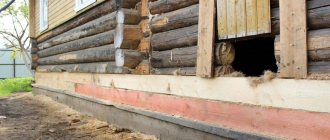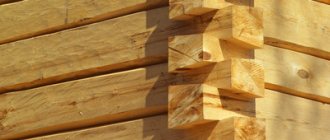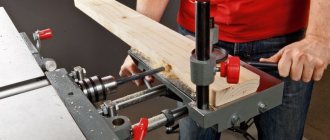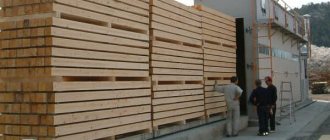Buildings made of logs and timber are durable; they can last for tens and even hundreds of years. However, time has a destructive effect on even the strongest materials, so sooner or later the foundation will require repairs. Rotting often affects the lower crowns, after which the house will gradually begin to lean on its side.
To prevent the destruction of the building, it is necessary to carry out a major overhaul of the foundation and replacement of the lower crowns. The first stage of this work is lifting the log house with a jack, which is important to carry out with the most accurate adherence to the technology.
Preparatory activities, building materials and tools for lifting
When preparing to raise a house on jacks, it is necessary to carry out the following preparatory measures:
- carry out a visual inspection;
- analyze the complexity of the work performed;
- estimate the duration of repair activities;
- select a moving method;
- prepare the building for relocation.
Based on external signs, it is easy to determine the need for repair measures.
Please note the following points:
- tilting of the house or skew of individual parts;
- cracking of outdoor finishes and interior coverings;
- partial or complete shrinkage of the house;
- displacement of part of the base;
- significant destruction of the supporting crown and foundation.
Before lifting the house with a jack, it is necessary to calculate the approximate load that falls on each corner.
Partial or complete movement of the building is carried out in order to perform the following restoration work:
- local restoration or overhaul of the foundation;
- preventing shrinkage of the building;
- dismantling rotten load-bearing beams along the contour of the building;
- eliminating distortions of walls and openings;
- performing antiseptic treatment of wooden structures;
- eliminating errors made during the construction process.
To make the right decision, you need to analyze a number of points:
- weight of the building. The jack for moving is selected according to its load capacity. The volume of the building box must be multiplied by the density of the wood, which is 700 kg/m3, then add the mass of the roof and cladding. The resulting value, multiplied by a factor of 1.4, corresponds to the load capacity of the device;
- dimensions of the building. With an increased building length of more than 6.5 meters, local shrinkage of wooden beams or beams is possible in the joining areas. In order to prevent distortions during movement, it is necessary to secure elements of additional reinforcement in the splice area;
Before you start lifting the house, you need to do a number of preparatory work
- features of interior decoration. Certain types of interior cladding significantly complicate the implementation of measures to move a building. Sheet plasterboard and traditional plaster can crack under the influence of deformation processes. For reinforcement, boards 5 cm thick are nailed on the street side;
- nature of the soil. The concentration of moisture in the surface layer of soil and its structure make certain adjustments to construction activities. The jack, under the influence of loads, can easily sink into soft and wet soil. The use of metal panels and concrete elements allows you to increase the supporting area;
- estimated vertical displacement. The design features of the lifting device limit the length of the rod extension. The required height of movement is achieved by gradually placing beams under the support platform of the device;
- duration of repair work. The duration of the activities depends on the complexity of the repair. It is risky to load the lifting rod for an extended period. It is necessary to use durable metal structures as temporary support for the structure.
Lifting the house to a convenient distance can be done in various ways:
- using a truck crane. Lifting equipment on wheels is used to lift a building in order to move it to another territory;
- using jacks. The use of small-sized lifting devices is popular when it is necessary to move light buildings vertically.
If you doubt the correct installation of the jack, you should stop the process of raising the house and place the tool correctly
Having decided to lift the house on screw or hydraulic supports, make the following preparations:
- turn off the electrical power supply;
- shut off the water supply lines;
- disconnect the sewer line;
- turn off the gas supply;
- dismantle the floor around the stove or in the boiler area;
- disconnect the gas boiler;
- ensure the box remains stationary with braces.
To carry out restoration measures, prepare:
- a jack whose load capacity corresponds to the calculated value;
- wooden panels to increase the area of the supporting surface;
- steel linings made of thick sheet material measuring 25x25 cm;
- tools necessary to dismantle the support beam along the contour of the building;
- grinder complete with discs for cutting metal and wood.
Having prepared your tools and materials, start lifting.
If the house moves sideways during lifting, install jacks on the side that turns out to be lower
Raising a building using jacks - precautions
Compliance with safety requirements when performing work is mandatory. Pay special attention to the following points:
- mandatory strengthening of the box with thick boards;
- installation of spacer beams in door and window openings;
- ensuring the immobility of the jack location;
- checking the strength and strengthening of wood in the area where the support rods are located;
- use of special steel thrust bearings.
By lifting and ensuring the structure is stationary, you can safely carry out repair work
Following the recommendations of professional builders, you can independently jack up the house to carry out repairs of varying levels of complexity. If you lack the necessary experience and self-confidence, it is advisable to entrust the work to professionals who will perform it with the utmost care. Compliance with technological recommendations will ensure smooth lifting and protect the structure from unexpected damage.
Source: pobetony.ru
House lifting technology
It is possible to raise a house without the use of special equipment; in this case, you will need to use hydraulic jacks that can handle a load weighing 10 tons. In order to dismantle the foundation, you should use a sledgehammer, a crowbar, and also dismantling wedges. Timbers, massive chocks and bricks can serve as temporary supports. And the boards will become spacers. The platform for installing the jack will be beams and boards, which should be combined into a shield; if such material is not available, you can use any other that is durable.
A steel plate, the minimum thickness of which should be 5 mm, will evenly distribute the forces exerted by the jack rod on the first crowns of the building. If work will be carried out with a foundation on supports with a back-up, the latter must be dismantled
At the preparatory stage, it is important to rid the building of heavy things and furniture. Moreover, the floor must also be disassembled. In order to raise the house onto the foundation, jacks should be installed on both sides at a distance of 0.5 meters from the corners
If the jacks are installed correctly, they will handle the lift. Errors when placing jacks can cause deflection of the beams, which are part of the lower frame, which will lead to uneven lifting, separation of the logs and their breakage. Before raising the house, you need to make sure that the jacks are located in places where the wood has not been exposed to rotten influences
In order to raise the house onto the foundation, jacks should be installed on both sides of it at a distance of 0.5 meters from the corners. If the jacks are installed correctly, they will handle the lift. Errors when placing jacks can cause deflection of the beams, which are part of the lower frame, which will lead to uneven lifting, separation of the logs and their breakage. Before raising the house, you need to make sure that the jacks are located in places where the wood has not been exposed to rot.
It is necessary to install gaskets, which can be steel plates, this will facilitate the correct transfer of forces to the bars from the jack rod. It is permissible to replace the plates with pieces of wood. Jacks should be installed on a prepared site; if necessary, they should be deepened into the soil, which will ensure their more reliable stability.
Concrete is first poured into the formwork and then compacted.
Sections of beams that are used in the process of arranging temporary supports should be used in such quantities as the lifting technology will require. If you intend to lift the entire house at once, the number of supports should be 2 times larger. The support should be assembled using sections of beams; ultimately, the support should take the shape of a well.
The supports must be given a height that is 10 cm greater than the difference in distance from the height of the jack to the ground. This is explained by the fact that during the lifting process the supports will settle, pressing into the soil. The technology involves lifting houses from both sides simultaneously, the lift on each side should be uniform, but at one time it should not exceed 1.5 cm. The result obtained must be immediately recorded using temporary supports.
Lifting can lead to kinks in the first rims, which indicates the need to install additional jacks. At this stage, it is necessary to ensure that the building does not move to the side, because then this will cause a change in the center of gravity.
In order to replace the foundation, the building will have to be raised to a height of at least 6 cm. Afterwards, the building can be lowered onto scraps of logs, which need to be placed on temporary supports.
After the house has been raised to the required height and secured with temporary supports, dismantling of the old foundation should begin. To do this, you will have to disassemble the rubble and brickwork using chisels, but you can use any tools that are convenient. Old supports must be removed from the ground by rocking them to the sides. Some materials that have been well preserved can be used in arranging the future foundation.
The fundamental structure is the support of a residential building, the destruction of which entails negative consequences. Old houses made of wood or panel material are lifted with a special device and a new foundation is formed. The construction of residential buildings without foundations is the choice of European developers. In the domestic space, this technology is just beginning to be developed and implemented. Therefore, most repairs involve raising a wooden house with your own hands.
What do experts advise?
According to reviews and advice from experts, the best jacks for raising wooden log houses are hydraulic jacks. Screw jacks can be used to lift the walls of frame and panel houses.
Photo: These small screw jacks will help lift not very heavy wooden structures.
Both types of jacks with a lifting capacity of two tons or more can lift the frame of a small house or bathhouse. According to the recommendations and reviews of wooden house construction specialists, it is necessary to raise wooden houses of log construction only after a detailed study of the structure of the wooden house itself. The whole point is in what scheme the bandaging of the lower crown with the floor beams of the subfloors is made. In different wooden buildings of a log structure, the fastening of floor beams and wall lining logs is different. The scheme for raising your timber frame structure will depend on this diversity.
The process of raising a house with your own hands step by step
The work depends on the weight and number of lifting points. At a minimum, it is enough to use one jack to raise the house. But this rule only works for small buildings. When using one lift, the vertical shift of corners is uneven. Therefore, the finishing of the house may become unusable. Doors and window frames may be skewed.
The use of two lifting mechanisms makes it possible to synchronize the lifting of the structure on one side and prevent serious deformation.
To simultaneously raise the walls, at least 4 devices are used, and if the walls are long, then more. In this case, small deformation of the building is guaranteed. After the work it will not require major repairs.
Preparation, shutdown of communications
Sewerage and water supply are disconnected so that the house does not collapse
Before lifting work begins, it is necessary to turn off all communications - electricity, water supply, sewerage, Internet cables, gas supply. Underground communications are disconnected or cut. Failure to do so may prevent lifting or cause damage to the building.
If there is a stove in the house, free movement of the pipe through the floors and roof is ensured. If its foundation is autonomous, that is enough. If the boiler is located on the floor of the building, it must be turned off and all connections and pipes removed. A wall-mounted boiler wouldn't hurt.
Jack installation
The installation method depends on the type of foundation. Rectangular niches for rolling are cut out in slabs or strips. Columnar or pile structures require spacers made of wooden panels. The installation site must be smooth and level. A three-legged stand is installed on it for height adjustment. For the linings you will need wooden plates at least 20 cm wide.
The correct installation of the jack depends on the condition of the log house:
- If the lower crowns are rotten, it is necessary to cut holes in them until there is a whole log, into which the head of the lift will rest.
- If the crown is intact, you will need a niche in the old foundation to install the foundation. A metal plate or piece of channel is installed under the jack to distribute the load-bearing load.
House lifting technology
If the walls are long, the number of jacks is increased for uniform lifting
The step-by-step jacking technique includes preparatory work and the following operations:
- Determine the number of jacks and lifting scheme.
- Level and compact the soil where the lifts are installed.
- The support area under the mechanism must be increased.
- Make a support plane at the point of contact of the jack with the tree. Cut down rotten wood to a hard surface. When replacing the lower crowns, it is necessary to cut above the rows being replaced.
- The supports must be lifted evenly, no more than 2-4 cm per cycle.
- As work progresses, it is necessary to install fixing gaskets and powerful stops to prevent the building from uncontrolled falling off the jacks.
- Constantly monitor the position of the house, its horizontal and vertical movement.
When performing work, you must pay attention to the following points:
- If the building structure is flimsy, it is necessary to strengthen it with thick boards.
- To prevent deformation, window and door openings are strengthened with spacers.
- It is necessary to check the strength of the wood where the rods are installed.
- At points of contact, it is necessary to place steel thrust bearings or thick boards from 50 to 100 mm.
When using one jack, its location is changed, and stones or cinder blocks are placed in the corners
Depending on the number of lifts, the lifting pattern will change:
- When using one jack, it is alternately rearranged under the corners of the building with a vertical movement of points of no more than 5 cm. This will avoid loosening of the structure and irreversible deformations of window and door openings. The raised area is securely fixed with stops, and the device is transferred to another area. So the house alternately rises to the desired level.
- When using two lifting mechanisms, they are located on one side of the building and rise synchronously. This allows you to reduce the distortion of the structure. The lifting algorithm is similar to using one lift.
- The synchronized operation of 4 or more devices allows you to raise a building quickly, as efficiently as possible, and safely. Alternating lifting in 1 cycle - no more than 2-4 cm. For synchronization, voice communication or professional equipment with synchronous lifting should be used.
Using this method, the house is raised to a height of 10 to 50 cm, which is quite enough to replace the foundation or crown of the house.
Dismantling the old base and installing a new one
So, the house is raised. Now you need to remove the old frame. To do this, use a chisel, a hammer drill and other complex powerful equipment. We are not in a hurry to throw away waste from the old foundation. They will still come in handy.
As soon as the old frame is removed, you can begin to form a pit for a new one. To do this, you can deepen the existing one a little or simply install a durable sand cushion 20 cm thick if the trench is deep enough. The sand is slightly moistened and compacted well.
- Formwork is installed in the trench, taking into account the bypass of those places where jacks and support posts are located. These holes can later be simply filled with bricks.
- A reinforcing belt is placed in the formwork, and care is taken that in the corners of the house it is bent and not welded. Since it is the corners of the building that will be responsible for the strength of the entire frame.
- The solution is poured into the prepared formwork and waited for it to dry completely.
- As soon as the concrete has dried, the crown logs are replaced if necessary. They can be tapped for rotting. If, when you knock on a log, it emits a ringing hum, then the wood is good. If the log has a dull echo, it means that it is rotting inside and requires replacement.
- Logs are replaced down to those that are well preserved.
Upon completion of all work, the house is also simultaneously and gradually lowered onto a new foundation. Windows, doors, floors and roof are returned to their place. The new foundation is sprinkled with the remains of the broken old foundation and compacted with soil.
A wooden log house is ready for use for another 30-40 years, provided that the wood is well cared for.
Foundation repair using screw piles
The piles are connected to each other by channels and form a kind of lattice. Afterwards, the house can be lowered onto the resulting lattice.
It is this method of maintaining the foundation in normal condition that has gained the highest popularity. This is not strange, because it is quite simple and not expensive. At the same time, its efficiency is at its best.
During construction, some people forget that the foundation is the most important part of the house. As a result, during operation, various cracks, chips, and so on appear on it.
This is a sure sign that the foundation needs repairs.
It is in this case that you will need to raise the foundation using jacks. In recent years, some residents of our country have begun to prefer a foundation on screw piles to an ordinary one. This is due to its many advantages over ordinary concrete.
The technology for replacing the foundation with screw piles is quite simple. Moreover, it will seem simple to those people who are reading this article, because it has already described how it is necessary to raise a house with the help of jacks. In this case, this process is the main one. So, the installation technology is as follows:
Based on the characteristics of the soil on which the piles will be installed, their exact number is calculated
This is a very important matter, because the integrity of the future structure will directly depend on it; it's worth raising the house. This is done according to the principle described above
Then you need to mark the perimeter on the territory of which all the piles will be located. It is very important to calculate the location of each of them. Piles should be installed at the corners of the building, as well as along the perimeter of the load-bearing walls; Next you need to start screwing in all the piles in turn. This can be done manually, but you can use special equipment; All piles are connected to each other by channels. They should form some kind of lattice. This will increase the rigidity of the structure; only after this the house can be lowered onto the resulting grid.
Now we can state the fact that the renovation of the foundation has been completed and it will delight its owners for many years.
Stage of raising a house, or working with a jack
Before lifting a house with your own hands, it is very important to prepare the areas where the jacks will be installed. Shields, boards or other material should be placed on each horizontal platform
It is advisable to make the supporting area as large as possible. A steel plate is laid from the jack's spot to the lower crown of the dwelling (which can be replaced with a corner of a suitable size). This will avoid damaging the log on the patch. Next, try a test lift. If there is a shift (from the vertical) of the jacks, the supporting platform is adjusted to fit the device (jack).
The house should be raised so that the height is from 30 to 40 mm. To lift houses, as a rule, two jacks are used at once. At least 2 people must take part in the work process. The next step will be to lay pads under the house, with the help of which the jacks can be released. After this, the same side is lifted. The lifting height of the house this time should be about 80 mm. Next, you should install the pads under the house.
After the first side of the house has been lifted, you should begin installing jacks on the opposite side of the house. Subsequent actions are similar to the previous ones. Next, return to the right side of the house again. After installing the jacks, lower the curtains, otherwise the tool may turn out from under the home. The actions already familiar to you are repeated in the same sequence until the house is raised.
When lifting houses, it is very important to consider the following rules:
If you doubt the correct installation of the jack, you should stop the process of raising the house and place the tool correctly. When lifting a house with a jack, under no circumstances should you crawl under the house. This also applies to arms and legs, no matter how secure the temporary pads may seem.
Particular care should be taken when lifting the house after it has rained, as temporarily installed supports may settle unevenly.
If the house moves sideways during lifting, install jacks on the side that turns out to be lower. In this case, the installation of the jacks will be slightly different; their position should not be vertical, but inclined. The slope should be directed towards the desired position in which the house should be (the angle should be approximately 60 degrees). Using jacks, you need to support the crown of the dwelling; a stop board nailed to a log is perfect for this.
This way, the house will stand more securely and will not begin to slide further. The other two jacks are used to raise the opposite part of the house (by 30 mm). Place a pipe section of ½ to ¾ inch diameter under the logs. After you have succeeded in lifting the house, lower it onto pre-prepared rollers. Your next steps (using jacks set at an angle) should be aimed at not only lifting the house, but also moving it horizontally.
If you succeeded in raising the house, but cannot move it horizontally, install the jacks at a smaller angle (between the axis of the tool and the ground from 45 to 60 degrees).
You should work with jacks slowly, performing several strokes with each tool in turn. Otherwise (if you work for a long time with only one of the tools placed under the house), the housing may gradually slide and twist around the pillar installed on the foundation. The house must be lifted strictly in the specified sequence.
- How to raise a house with jacks?
- The process of raising a wooden house on jacks
As houses are used, their structures wear out over time. To a greater extent, this applies specifically to wooden houses made of timber, in the construction of which materials that have not undergone special treatment were used. Despite the fact that wood is the most environmentally friendly material, if construction technology is violated, its beneficial qualities may decrease.
For preventive purposes, it is necessary to replace or repair the foundation once every 15-20 years.
After a long time, the lower row of wooden beams may begin to rot under the influence of moisture, losing its load-bearing capacity. To prevent the destruction of the house, rotten beams should be replaced with new materials, and for this it is necessary to raise the entire structure. Therefore, let's look at how to raise a wooden house on your own.
Selecting jacks for lifting a house and installing them
When choosing jacks for the job of moving a house to a new foundation, it is necessary to calculate the approximate weight of the house to determine the load. The weight of the building material that was used to construct walls, partitions, and roofing is taken into account. The result obtained is divided by four. This will be the load on one corner of the house.
You need to choose a jack with a reserve load capacity. Depending on the size of the house and materials, devices with a lifting capacity of 5 or 10 tons are used. You can rent such equipment from railway companies or from drivers of heavy trucks. The degree of load is also taken into account when choosing materials that will temporarily support the house.
Jacks require reliable support to prevent them from being crushed under load. They must be installed on wooden panels, even if the device is located on a concrete surface. It is advisable to lay a metal sheet under the base of the jack. A steel plate will also be needed for the head of the device. There should be a recess or milling in its center to prevent slipping.
Preparatory stage
It must be said right away that we are talking about how to raise a log, timber or panel house. Professionals do not recommend lifting a brick or frame house yourself.
This requires special technologies and equipment. Before you begin lifting a building, you need to be properly prepared.
The first step is to carry out the necessary calculations. The point of the calculations is to determine the magnitude of the load on the corner of the building. To do this, calculate the total weight of the house and divide it by 4.
Based on this value, you need to select a sleeper or board of a certain cross-section that will be used as temporary support.
In everyday practice, people use jacks of various types and purposes. They can be used to lift both vehicles and wooden buildings.
According to their design, jacks are divided into the following types:
To lift a wooden structure, you need to use a screw jack. All other types are not suitable for these purposes. One jack will be enough for the job. If there are two of them, the lifting process will speed up.
It is not recommended to lift a structure using four devices at the same time. In this case, the risk of building skewing increases.
The next step is to determine the location for installing the jack and prepare all the materials and equipment necessary for the work.
You will need two metal plates to place under the jacks. Instead, you can use scraps of boards 5 cm thick or more. On the façade side, two slats are attached to the corners of the house.
If this device is not available, then the marking can be done using a plumb line and an ordinary building level. The slats must be securely fastened. Marks are applied both to the batten and to the corner of the building.
When the wall rises, the gap between these marks will be equal to the height of the rise
It is very important to install the jack correctly
It should be located under the lowest log and support it. The photo shows a jack installed under the bottom log of a wooden house.
It must be installed on pre-compacted soil. But this can be difficult to do. Therefore, either a board or a steel plate is placed under the base of the jack.
A steel plate measuring 15x15 cm must be placed under the head of the jack. The plate is needed to ensure that the log does not slip off the head.
What buildings can be raised
Using modern technological techniques, one-story wooden buildings can be easily jacked up. The materials used for such buildings are:
- rounded logs;
- square and rectangular beams;
- prefabricated panels covered with planed boards or slabs.
The small size and weight of wooden buildings make them easier to move.
It is necessary to carefully prepare for the process of lifting a house with a jack and learn all the intricacies of the technology.
Preparatory work, necessary materials and tools
At the preparatory stage, it is necessary to inspect the building, assess the degree of complexity and duration of the planned repairs, determine the method of lifting, and carry out work to protect the structure from destruction during movement.
If there are problems with the foundation, there are two options - build a new house or try to restore and replace it
The need for repairs by lifting a wooden building is indicated by visual signs:
- significant skew or tilt of the house;
- the appearance of a network of cracks on the interior and exterior finishes;
- local or complete subsidence;
- deepening part of the foundation into the ground;
- significant violation of the integrity of the foundation.
The vertical movement of the structure is carried out to carry out the following types of activities:
- Performing partial or major repairs of the foundation.
- Preventing subsidence of the structure.
- Replacement of rotted support beams around the perimeter of the building.
- Alignment of box distortions.
- Carrying out protective treatment of wood.
- Eliminating mistakes made by builders.
Most often it is necessary to raise a wooden house when problems arise with the foundation
In order to determine the method by which the house will be raised using special devices, the following factors are analyzed at the preliminary stage:
- mass of the building. Each jack must provide a 40% lifting capacity. To do this, the total weight of the structure is calculated by multiplying the cubic capacity of the box by the specific gravity of wood equal to 0.8 t/m3. The weight of the floor, roofing and finishing is added to the resulting number;
- dimensions of the building box. With a building length of more than six meters, there is a high probability of beams or logs subsiding in the splice zone. Additional installation of supporting elements at the joining areas will be required;
- presence of internal lining. Using plasterboard sheets or plaster to decorate walls indoors complicates the implementation of activities. Installing 50 mm thick boards on the outside of the corners will avoid repeated repairs indoors;
- soil features. Depending on the structure of the soil on which the lower plane of the lifting device will rest, it may be necessary to use concrete blocks or special panels of increased area. This will prevent the jack from sinking;
- travel height. The length of the working stroke of the rod is limited by the design of the lifting device. The use of special pads made of durable square-section timber with a side size of 100–150 mm will allow you to gradually achieve the required moving height;
- duration of repair activities. The duration of the repair is determined by the degree of complexity; if it is carried out for a long time, it is undesirable to rest the structure on the rod. It is advisable to use temporary structures made of metal and wood that have sufficient supporting area.
Sometimes a bad site is chosen to build a building, then they put a new foundation in another place and drag the house
Raising the house to the height required for repairs can be carried out using the following equipment:
- By crane.
It is used mainly for the purpose of lifting to move buildings to another site. - Powerful jacks.
A widespread method of moving wooden buildings in a vertical plane.
When planning to raise a house on jacks, you should prepare:
- cut off the power supply;
- turn off the gas supply;
- shut off water mains;
- turn off the sewer system;
- ensure free movement of a stove installed on an independent foundation through the roof of the chimney;
- disconnect the individually mounted boiler from the heating pipes;
- dismantle the floor in the area of the stove and heating boiler;
- secure the immobility of the box with steel plates screwed to the corners.
Use a jack to lift the frame slightly. Only 2-3 cm at a time
To complete the work you will need the following materials and tools:
- Hydraulic type jack with a lifting capacity corresponding to the design value.
- Support panels made of wood, allowing to reduce the load on the ground when installing lifts.
- Set of metal pads measuring 20–30 cm.
- Grinder equipped with a disc.
- A set of tools for detaching the support beam around the perimeter of the building.
Signs of Problems
There are several such signs and they can be seen almost with the naked eye.
Namely: partial or complete violation of the foundation of the house; deepening the foundation into the ground; subsidence of the building in one of the corners; large distortion of windows and doors, as well as the tilt of the building. After inspection and identification of many additional works, a decision is made to raise the house. At the same time they create a plan according to which they purchase the necessary building materials and tools. In addition, the following activities are planned for major repairs:
- replacement of rotten building crowns;
- preventing further subsidence;
- alignment of the distortion of the entire box around the perimeter;
- treating wood with chemicals to prevent rotting;
- complete or partial replacement of the foundation.
Such grandiose work is carried out within 1 - 2 weeks , involving the entire family and several invited specialists.
Preparation
The process of raising a wooden house with jacks with your own hands is not very difficult, but in order for everything to go as it should, you need to thoroughly prepare for the work and act without haste.
It is important! In autumn and spring it often rains, due to which the soil becomes limp (and the groundwater level becomes higher), so the jack will get stuck in it. It is better to do the work in the dry season
Interior of the house and communications
To make the structure as light as possible, it is recommended to remove furniture from the house.
You also need:
- disconnect the water heating pipes from the boiler installed on a separate foundation;
- disconnect the gas pipeline from the house (the work is performed by a gas service specialist);
- it may be necessary to disconnect the power lines;
- dismantle part of the sewer leaving the building.
A visual inspection will help determine what else is in the way - it could be trees, their branches, bushes, etc.
How to avoid common mistakes
When lifting a house with a jack, the following mistakes are most often made:
- They forget to disconnect the last crown from the foundation
- They raise one wall of the house too much
- The jack is installed unsteadily and shaky
- Do not place plates between the mechanism and the crown
- Using supports that are too thin and narrow
If, when lifting the house, you notice late that you forgot to disconnect the frame crown, then you will have to caulk the entire frame, because lifting the logs will pull the arches away from each other.
Some mistakes can lead to the fact that the log house will have to be re-caulked Source images.ru.prom.st
If you lift up one wall too much, the windows and doors may jam. Also, the beams can warp, which is why the entire building will have to be caulked. Poor installation of the jack can lead to it sagging or slipping out from under the crown.











